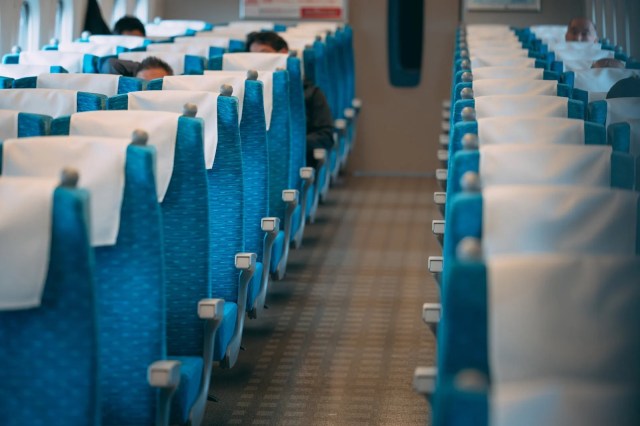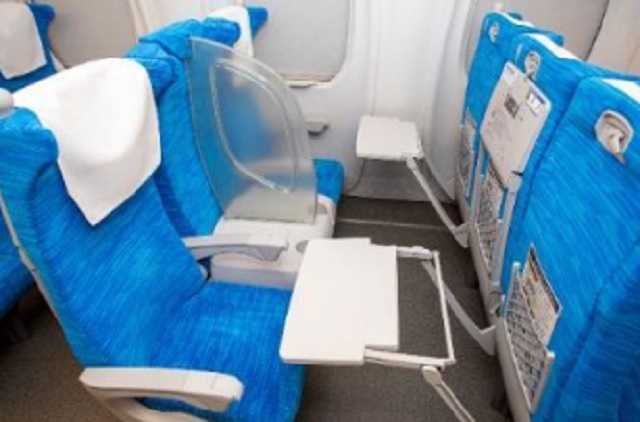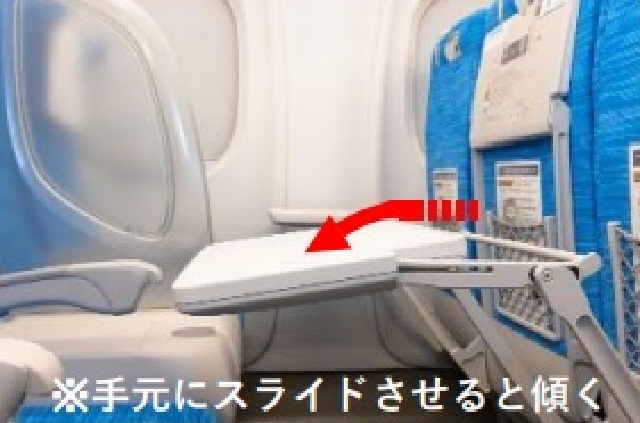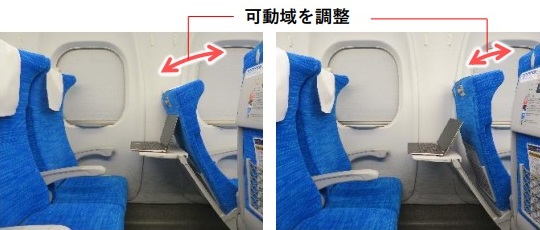
50-percent-wider seats are aimed at business travelers on the Tokyo-Osaka route.
The interior of Japan’s Shinkansen bullet train cars usually have an asymmetrical layout. As shown in the photo above, there are rows of two side-by-side seats on one side of the middle aisle, and rows of three adjacent seats on the other.
However, this month some Shinkansen cars are being remodeled, and will have sections with two seats on either side of the aisle. They’re not ripping seats out, though, but making some of the seats 50 percent wider.
▼ The extra-wide seats have a partition between them.
This change, however, isn’t in response to the Japanese population getting girthier, or to accommodate on-average larger-framed tourists from abroad. Instead, business travelers are the target market for these special seats, which can be seen in the video here.
A while back, JR Central, which operates the Tokkaido Shinkansen line which connects Tokyo, Kyoto, and Osaka (and by seamless extension into the Sanyo Shinkansen line also Hiroshima and Fukuoka), began designating the seventh car on its Nozomi-class bullet trains as the S Work car, likely short for “Shinkansen Work.” The idea was to present the S Work car as a place where business travelers who need to get some work done while in transit could clack away on their laptops without feeling guilty or self-conscious that the noise or keeping their seatback trays extended would be an annoyance for leisure travelers.
This month, though, JR Central is further differentiating the S Work car with the introduction of the S Work P Seat (P probably short for “premium”). The area that used to be the middle seat of the three-seat rows is converted into extra elbow room and an integrated cup holder. S Work P Seats also have redesigned seatback trays with surfaces that can be tilted up slightly instead of being left flat, creating a more ergonomic angle like what a laptop stand offers.
In addition, S Work car seat have been modified to not recline as far as seats in other cars, in order to preserve more usable space on the seatback tray for laptops or other work-related mobile devices.
▼ Standard maximum recline (left) versus S Work maximum recline (right)
Even if you’re not working on the train, the S Work P Seat does give you a little more space to stretch out your upper body laterally. On the other hand, the central section is not flush with the rest of the seat, so your hindquarters won’t have any more room than in a normal seat.
The S Work P Seat will be available on not just JR Central’s Nozomi trains, but also its Hikari and Kodama-class Shinkansen starting October 20, and carry an additional charge of 1,200 yen (US$8) over the standard fare.
Source: Livedoor News/Nitele News via Hachima Kiko, JR Central
Top image: Pakutaso
Insert images: JR Central
● Want to hear about SoraNews24’s latest articles as soon as they’re published? Follow us on Facebook and Twitter!




 Nozomi Shinkansen bullet train abolishes low-priced unreserved tickets during peak travel seasons
Nozomi Shinkansen bullet train abolishes low-priced unreserved tickets during peak travel seasons Shinkansen travel tip: A clever way to keep your suitcase from rolling around on the bullet train
Shinkansen travel tip: A clever way to keep your suitcase from rolling around on the bullet train New private rooms on Tokaido Shinkansen change the way we travel from Tokyo to Kyoto
New private rooms on Tokaido Shinkansen change the way we travel from Tokyo to Kyoto Free Shinkansen tickets for kids travelling with parents during special JR promotion
Free Shinkansen tickets for kids travelling with parents during special JR promotion Tokaido Shinkansen ending in-train food/drink sales for all non-first-class-passenger cars
Tokaido Shinkansen ending in-train food/drink sales for all non-first-class-passenger cars Foreigner’s request for help in Tokyo makes us sad for the state of society
Foreigner’s request for help in Tokyo makes us sad for the state of society Japanese city loses residents’ personal data, which was on paper being transported on a windy day
Japanese city loses residents’ personal data, which was on paper being transported on a windy day Seaside scenery, history, and so many desserts on Yokohama’s Akai Kutsu【Japan Loop Buses】
Seaside scenery, history, and so many desserts on Yokohama’s Akai Kutsu【Japan Loop Buses】 Ghibli Park now selling “Grilled Frogs” from food cart in Valley of Witches
Ghibli Park now selling “Grilled Frogs” from food cart in Valley of Witches Historical figures get manga makeovers from artists of Spy x Family, My Hero Academia and more
Historical figures get manga makeovers from artists of Spy x Family, My Hero Academia and more Suntory x Super Mario collaboration creates a clever way to transform into Mario【Videos】
Suntory x Super Mario collaboration creates a clever way to transform into Mario【Videos】 Akihabara pop-up shop sells goods made by Japanese prison inmates
Akihabara pop-up shop sells goods made by Japanese prison inmates Japan’s massive matcha parfait weighs 6 kilos, contains hidden surprises for anyone who eats it
Japan’s massive matcha parfait weighs 6 kilos, contains hidden surprises for anyone who eats it New adorable, two-color Vulpix airplane will take you to Hokkaido, not even for a limited time
New adorable, two-color Vulpix airplane will take you to Hokkaido, not even for a limited time Japan removes tour guide requirement for foreign tourists
Japan removes tour guide requirement for foreign tourists McDonald’s new Happy Meals offer up cute and practical Sanrio lifestyle goods
McDonald’s new Happy Meals offer up cute and practical Sanrio lifestyle goods Japanese ramen restaurants under pressure from new yen banknotes
Japanese ramen restaurants under pressure from new yen banknotes French Fries Bread in Tokyo’s Shibuya becomes a hit on social media
French Fries Bread in Tokyo’s Shibuya becomes a hit on social media Studio Ghibli releases new action figures featuring Nausicaä of the Valley of the Wind characters
Studio Ghibli releases new action figures featuring Nausicaä of the Valley of the Wind characters New private rooms on Tokaido Shinkansen change the way we travel from Tokyo to Kyoto
New private rooms on Tokaido Shinkansen change the way we travel from Tokyo to Kyoto Red light district sushi restaurant in Tokyo shows us just how wrong we were about it
Red light district sushi restaurant in Tokyo shows us just how wrong we were about it Tokyo Tsukiji fish market site to be redeveloped with 50,000-seat stadium, hotel, shopping center
Tokyo Tsukiji fish market site to be redeveloped with 50,000-seat stadium, hotel, shopping center All-you-can-drink Starbucks and amazing views part of Tokyo’s new 170 meter-high sky lounge
All-you-can-drink Starbucks and amazing views part of Tokyo’s new 170 meter-high sky lounge Beautiful Ghibli sealing wax kits let you create accessories and elegant letter decorations【Pics】
Beautiful Ghibli sealing wax kits let you create accessories and elegant letter decorations【Pics】 Studio Ghibli releases Kiki’s Delivery Service chocolate cake pouches in Japan
Studio Ghibli releases Kiki’s Delivery Service chocolate cake pouches in Japan New definition of “Japanese whiskey” goes into effect to prevent fakes from fooling overseas buyers
New definition of “Japanese whiskey” goes into effect to prevent fakes from fooling overseas buyers Our Japanese reporter visits Costco in the U.S., finds super American and very Japanese things
Our Japanese reporter visits Costco in the U.S., finds super American and very Japanese things Studio Ghibli unveils Mother’s Day gift set that captures the love in My Neighbour Totoro
Studio Ghibli unveils Mother’s Day gift set that captures the love in My Neighbour Totoro More foreign tourists than ever before in history visited Japan last month
More foreign tourists than ever before in history visited Japan last month New Pokémon cakes let you eat your way through Pikachu and all the Eevee evolutions
New Pokémon cakes let you eat your way through Pikachu and all the Eevee evolutions Sales of Japan’s most convenient train ticket/shopping payment cards suspended indefinitely
Sales of Japan’s most convenient train ticket/shopping payment cards suspended indefinitely Sold-out Studio Ghibli desktop humidifiers are back so Totoro can help you through the dry season
Sold-out Studio Ghibli desktop humidifiers are back so Totoro can help you through the dry season Japanese government to make first change to romanization spelling rules since the 1950s
Japanese government to make first change to romanization spelling rules since the 1950s Ghibli founders Toshio Suzuki and Hayao Miyazaki contribute to Japanese whisky Totoro label design
Ghibli founders Toshio Suzuki and Hayao Miyazaki contribute to Japanese whisky Totoro label design Doraemon found buried at sea as scene from 1993 anime becomes real life【Photos】
Doraemon found buried at sea as scene from 1993 anime becomes real life【Photos】 Tokyo’s most famous Starbucks is closed
Tokyo’s most famous Starbucks is closed One Piece characters’ nationalities revealed, but fans have mixed opinions
One Piece characters’ nationalities revealed, but fans have mixed opinions We asked a Uniqlo employee what four things we should buy and their suggestions didn’t disappoint
We asked a Uniqlo employee what four things we should buy and their suggestions didn’t disappoint Princesses, fruits, and blacksmiths: Study reveals the 30 most unusual family names in Japan
Princesses, fruits, and blacksmiths: Study reveals the 30 most unusual family names in Japan New Shinkansen bullet train design revealed for Nagasaki extension
New Shinkansen bullet train design revealed for Nagasaki extension Is the new Shinkansen Train Desk ticket worth it?
Is the new Shinkansen Train Desk ticket worth it? Shinkansen will require reservations for large suitcases, charge penalty fees for those without
Shinkansen will require reservations for large suitcases, charge penalty fees for those without Japan Rail now accepting suggestions for how to use a car on the Nozomi bullet train in March 2022
Japan Rail now accepting suggestions for how to use a car on the Nozomi bullet train in March 2022 Is it OK to play with Pokémon card on the Shinkansen? A bullet train manners debate
Is it OK to play with Pokémon card on the Shinkansen? A bullet train manners debate All Japan Railway Tokyo trains to finally get security cameras starting this summer
All Japan Railway Tokyo trains to finally get security cameras starting this summer Shinkansen driver disciplined for taking poop break while train was going 150 kilometers an hour
Shinkansen driver disciplined for taking poop break while train was going 150 kilometers an hour JR group offers all-you-can-ride passes for older couples in “Full Moon Couple Green Pass” deal
JR group offers all-you-can-ride passes for older couples in “Full Moon Couple Green Pass” deal Japan’s ultra-classy overnight bus gives you your own sleeping pod【Photos】
Japan’s ultra-classy overnight bus gives you your own sleeping pod【Photos】 Potentially dirty and broken used Shinkansen food/beverage carts on sale in Japan for 100,000 yen
Potentially dirty and broken used Shinkansen food/beverage carts on sale in Japan for 100,000 yen Tourists can (finally) make shinkansen reservations from overseas with new app
Tourists can (finally) make shinkansen reservations from overseas with new app All-you-can-ride Shinkansen deal coming to Japan for a limited time
All-you-can-ride Shinkansen deal coming to Japan for a limited time Schedule released for Japan’s “Contemporary art bullet train”
Schedule released for Japan’s “Contemporary art bullet train” JR West unveils new Japanese long distance train with special features for passengers
JR West unveils new Japanese long distance train with special features for passengers New JR Shinkansen-inclusive rail pass is a huge bargain, great way to help out a region in need
New JR Shinkansen-inclusive rail pass is a huge bargain, great way to help out a region in need Japan’s newest Shinkansen is world’s fastest gallery, packed with contemporary art inside and out
Japan’s newest Shinkansen is world’s fastest gallery, packed with contemporary art inside and out
Leave a Reply